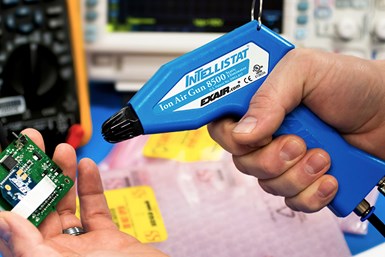Exair Ion Air Gun Swiftly Reduces Static
Exair has added the Intellistat Ion Air Gun, which can reduce 1000V of static down to 100V in under a second, to its Gen4 static eliminator product line.

Exair's (Cincinnati, Ohio) Intellistat Ion Air Gun is a handheld, lightweight solution for static elimination in clean processes or sensitive assembly work such as that taking place in scientific and electronic test facilities, laboratories and clean rooms. Exair designed the Intellistat to consume minimal compressed air while simultaneously delivering precise blow-off. The company also says the Intellistat achieves static decay rates capable of reducing 1000V to less than 100V in under a second at up to 24” away.
The Intellistat includes a short-throw trigger which Exair says requires minimal effort. In addition to integrating a low-voltage transformer that converts 120V to 24V, Exair designed an air nozzle to maximize efficiency and meet OSHA requirements for sound level and dead-end pressure. An LED light signals red or green to signify proper functionality, and a hook facilitates easy hanging and storage.
Exair says the Intellistat is a low-maintenance addition to its Gen4 static eliminator product line, one that is both UL-listed and CE-compliant. The company also recommends the device in applications requiring non-conductivity — such as circuit board or electronics manufacturing or testing — due to its durable static dissipative polycarbonate construction.
Exair Corporation | 800-903-9247 | exair.com
Related Content
-
Ultrafiltration Membranes, Filter Elements for Improved Industrial Water Reuse
Ultrafiltration membranes help with water reuse in a variety of applications.
-
NASF/AESF Foundation Research Project #121: Development of a Sustainability Metrics System and a Technical Solution Method for Sustainable Metal Finishing - 15th Quarterly Report
This NASF-AESF Foundation research project report covers the twelfth quarter of project work (October-December 2023) at Wayne State University in Detroit. In this period, our main effort focused on the development of a set of Digital Twins (DTs) using the Physics-Informed Neural Network (PINN) technology with application on parts rinsing simulation.
-
NASF/AESF Foundation Research Project #122: Electrochemical Approaches to Treatment of PFAS in Plating Wastewater - 9th Quarterly Report
The NASF-AESF Foundation Research Board selected a project addressing the problem of PFAS and related chemicals in plating wastewater streams. This report covers the ninth quarter of work (January-March 2023). In this report, we describe our work on evaluating the performance of PFAS degradation by electrooxidation using surface fluorinated Ti4O7 anodes in batch mode.












.jpg;maxWidth=300;quality=90)
